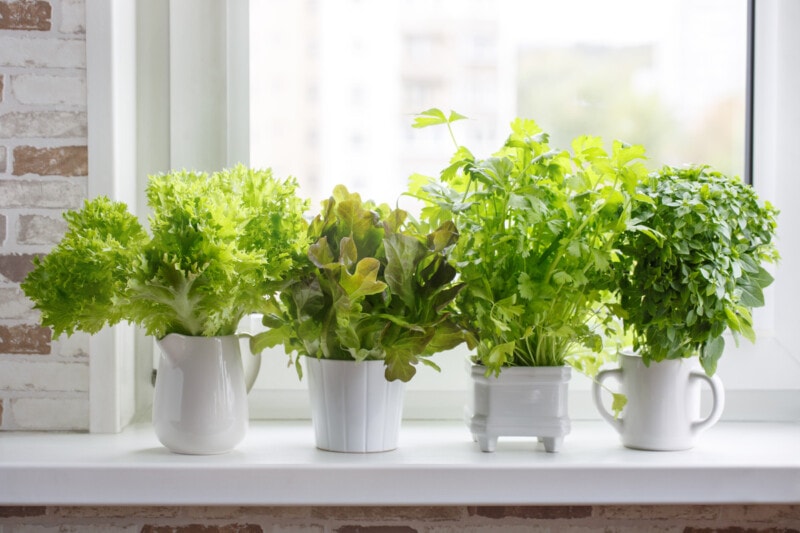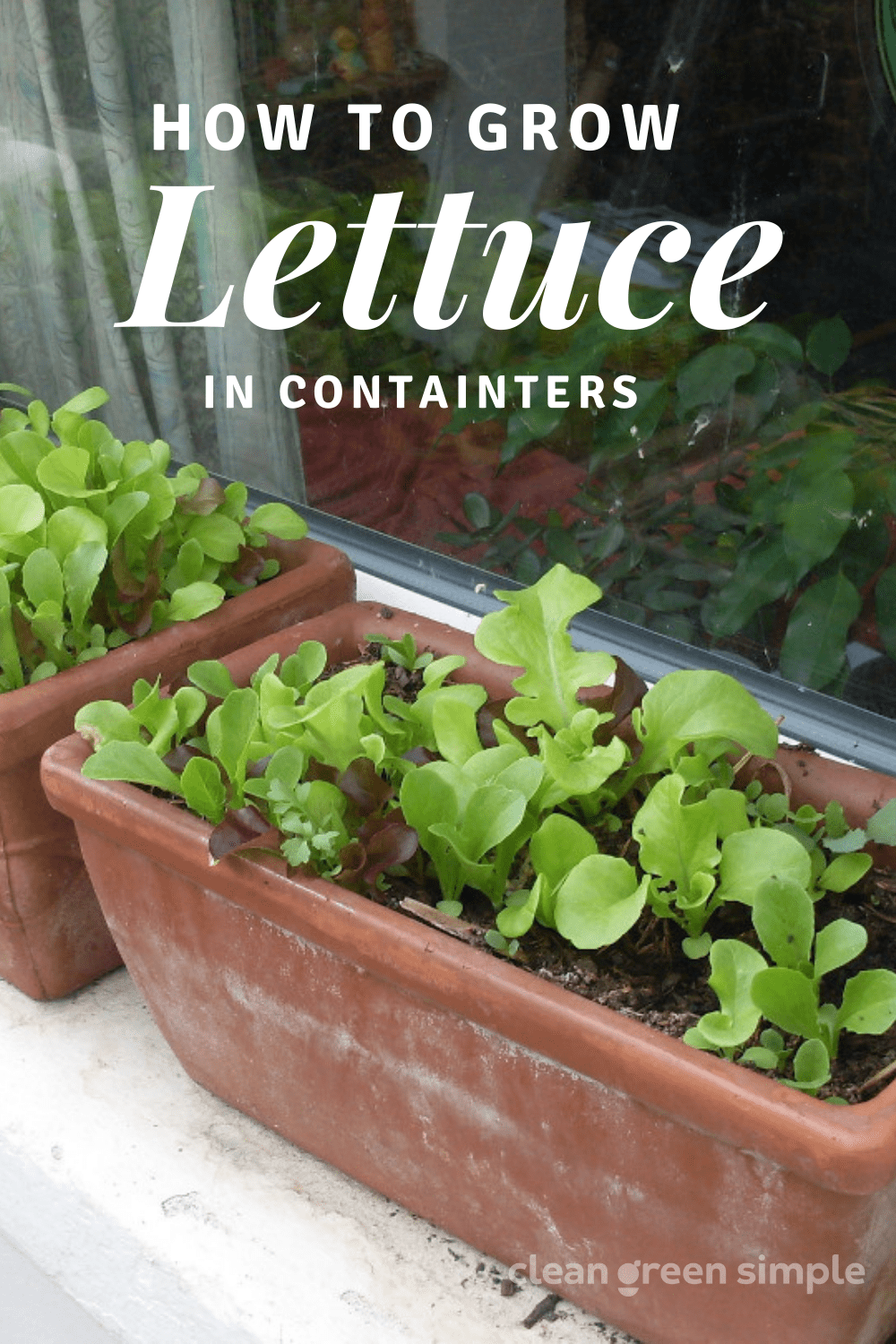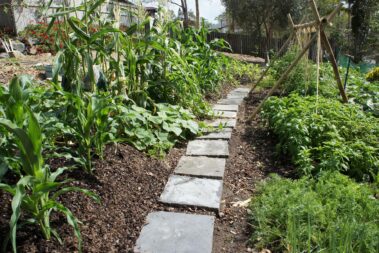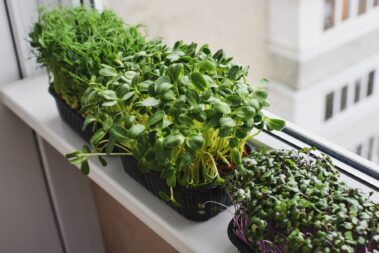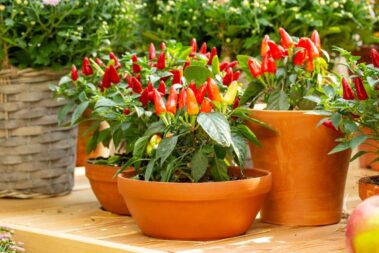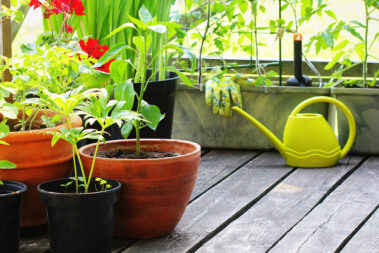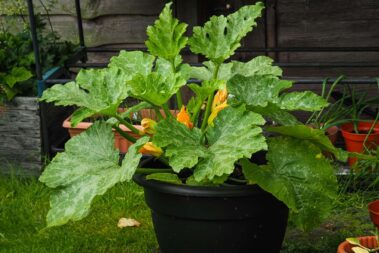In this article, we’ll show you how to grow lettuce plants in pots in eight simple steps. We’ll also walk you through some common problems that crop up when growing in containers and how to handle them, plus some tips for using greens in the kitchen.
Table of Contents
8 Tips for Growing Lettuce in Pots
Now that you know the many advantages of a lettuce container garden, here are some tips to help you create your own.
1. Pick a Cool Location with Plenty of Sunlight
Almost all lettuce varieties and most greens are cool season plants. This means they thrive when the average temperature is below 70 degrees.
This doesn’t mean they don’t like sunlight, however. Six hours of light per day is adequate for most types, but more will help your plants mature faster.
When starting your garden in early spring, look for a spot that gets plenty of southern exposure. As the season warms, you can move your pots to an area that gets more morning sunlight but is spared from the burning heat of the afternoon.
For greens started in the early fall, begin with the pots in that cooler eastern location and move them to the warmer, south-facing spot as the weather cools.
2. Find a Pot that Maximizes Surface Area
Lettuces have fairly short root systems and only require about 6 inches of soil. Choosing a shallower, longer pot will give you more surface area, which means room to grow more plants.
Many greens, like spinach and kale, also do well in these shallow, elongated pots. However, other type of greens, such as turnip and beet, require much more root space. For these types, choose a pot that’s at least 12 inches deep.
Whichever pot you choose, ensure it has multiple drainage holes along the bottom to keep water from collecting around the plant’s roots.
3. Start with the Right Garden Soil
Lettuce is 95% water, which means it requires near-constant access to moisture to avoid wilting. At the same time, it does not do well in standing water.
To meet this balance of moist but not boggy, you need to fill your pot with a high-quality potting garden soil, containing plenty of organic matter or compost. This specialty soil holds onto moisture better than normal dirt while simultaneously allowing for quick drainage of excess water.
Fill your pots with potting soil and then drench the soil in water. It may help to set the pot in a dish or large tray and allow it to sit in water for a few hours. This will encourage the soil to take up as much moisture as possible before planting begins.
4. Choose the Right Varieties
There are plenty of lettuce and greens varieties to choose from. Some are better suited to the restricted growth conditions of containers than others. Here are a few of our favorite varieties:
- Rubygo Lettuce – A one-cut red leaf lettuce with a ton of flavor
- Verigo Lettuce – Exceptional flavor with a serrated leaf for one-cut harvesting
- Green or Red Oakleaf Lettuce – Delicate green or red leaves for cut-and-come-again harvesting
- Red Romaine Lettuce – A classic for salads that can be harvested in baby or mature form
- Arugula – Thick green leaves with a deep, almost bitter flavor for adding character to salads and burgers
- Kale – Comes in many varieties, all can be harvested in baby or mature form
- Spinach – Another classic that grows well in small spaces
- Chard – Requires more space, but makes a great addition to homemade juices and is delicious when sauteed
Almost all varieties of lettuce can be grown in containers. But loose leaf types tend to do better and require less space than full-head varieties. Some are meant to be grown to maturity and harvested only once, while others can be picked in baby-leaf form or harvested a few leaves at a time.
The term “greens” describes a wide range of different plant types, from root veggie leaves to familiar salad additions like kale. Each type of green comes with its own special considerations and harvesting requirements.
5. Sow Your Seeds in Cool Weather
Most greens and lettuces do best when sowed directly into the pot they will be grown in.
To maximize your growing season, prepare your pots inside next to a sunlit window a few weeks before the last hard frost in spring or a few weeks before the temps begin to drop in late summer.
If you plan to harvest your greens as “baby” leaves, simply sprinkle the seeds over moist soil, then gently agitate the soil to cover them. There is no need to thin in this case. Simply harvest the immature leaves as needed.
If you plan only to harvest mature heads, make a small indent about ¼ inch deep every few inches. Drop a pinch of seeds in each hole and gently cover. As the seedlings develop, thin according to the package directions and weed as needed.
Lettuce seeds and many greens seeds need light to germinate, so be careful not to sow them too deep.
Once the sprouts are a couple of inches tall and the risk of hard frost or extreme heat has passed, you can move the pot outside.
6. Water Consistently
As your plants begin to grow, check the soil each day. If it feels dry to the touch, add water. The drainage holes in the bottom of the pot should assure the soil doesn’t become over-saturated, so careful not to water too much. If you are using a saucer or tray under the pot, make sure to empty it of standing water each day.
Greens and lettuce are easy keepers and do not require a lot of nutrients. As long as you started with a quality, fresh potting soil, you should not need to fertilize. If you reuse the same soil for a fall harvest, add some liquid fertilizer before sowing your seeds.
7. Harvest and Harvest Again
One of the best things about growing greens and lettuce is you can continue to harvest most varieties and they will just keep growing.
For these “cut and come again” types, simply snip off the outermost leaves as needed. The plants will continue to grow and expand from the center throughout the season.
It’s best to harvest lettuce plants all at once toward the end of the season. For these, simply cut off the entire head once the weather heats up or before the first hard frost of fall. Cut-and-come-again varieties should also be final-harvested in this manner.
8. Keep an Eye on the Temperature
For fall harvests, keep an eye out for frost warnings. Most lettuces and greens are hardy and can withstand light frosts without problems. For lower temps, though, it is best to move the pots inside or do a complete harvest and start again in the spring.
For spring crops, you will want to look for signs of bolting.
When temperatures begin to warm and daylight increases, these plants will shift from producing leaves to producing flowers. When this happens, you will notice the center stalk begin to elongate. Once the flower stalk forms, the leaves become bitter and useable.
Doing a complete harvest is the only way to avoid losing your crop once bolting begins. But to ward off bolting, you can try moving your pots to a cooler location or setting up a shade sail to lower the afternoon temperatures. These measures will help you extend your season by a few weeks.
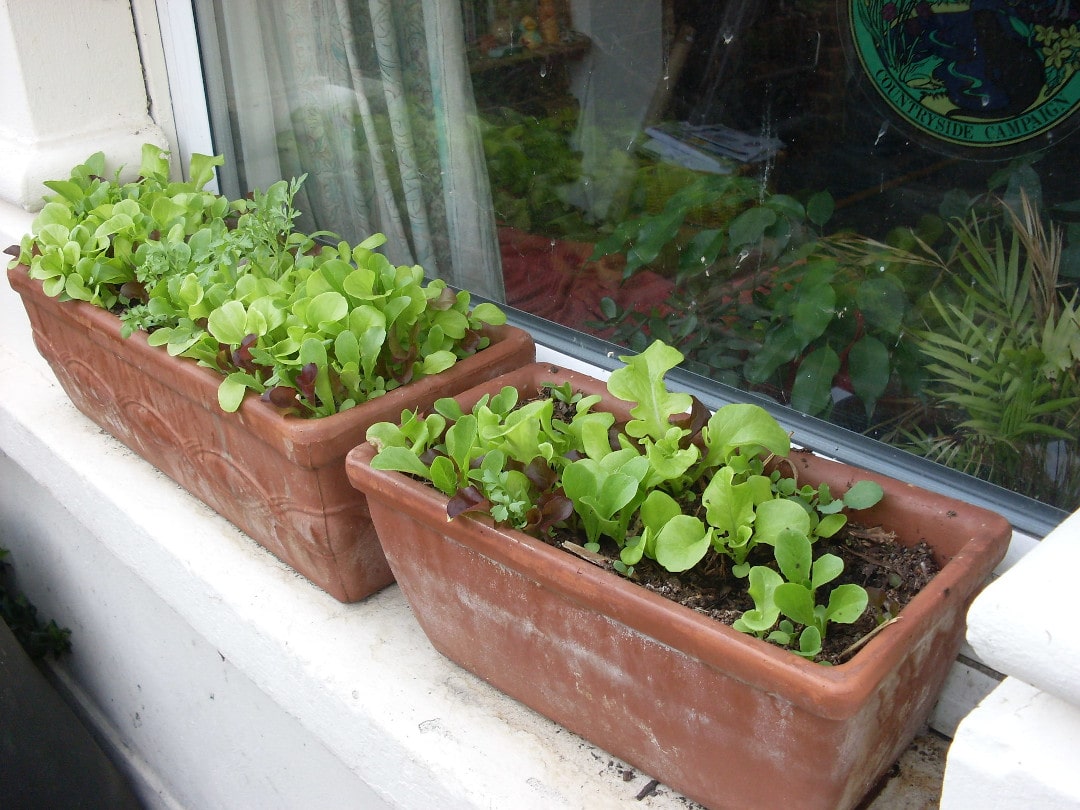
The Advantages of Growing Lettuce In Containers
Growing greens and lettuce plants in containers limits your growing space and harvest size. But this drawback is usually more than made up for by the many benefits that come with growing these vegetables in pots rather than in the ground.
Earlier Start to the Season
By growing your greens in containers, you can easily extend your season by starting earlier.
Lettuce, spinach, and other delicate greens prefer growing in cool weather. But in most climates, this means waiting until after the last hard frost to sow your seeds.
When using pots, you have the option to bring your containers inside to plant your seeds to give them a head start. Once they have sprouted and matured some, and the threat of frost has passed, you can move them outdoors. While others are still waiting for their sprouts to grow in their gardens, you’ll be ready to trim your first harvest.
In hotter climates, you can start your lettuce indoors for a fall crop. By the time the sprouts have matured, the summer temps will have cooled enough to put the lettuce outside. By getting this head start, you’ll get more harvests in before the first hard frost.
Better Temperature Control
The mobility of a container garden also means you have more power to control what temperatures your greens are exposed to throughout the growing season.
In the early spring and late fall, unexpected hard frosts can kill your lettuce. In the summer, hot days encourage bolting which shortens the harvest period.
During these times, pots can be moved inside to stay warm, or to cool areas of the yard or patio to avoid getting boiled by the summer sun.
Fewer Issues with Pests
One of the hardest parts about growing lettuce and greens is dealing with all the bugs that like to chomp on those delicate leaves.
Luckily, bugs are much less of an issue for container gardens.
The soil can be completely replaced each spring, which means no issues with pests and their eggs overwintering. Plus, the plants are much less accessible for bugs that are passing through. Plants that are experiencing issues with pests can quickly be isolated to avoid the issue spreading to the entire crop, as well.
Common Problems You Might Face
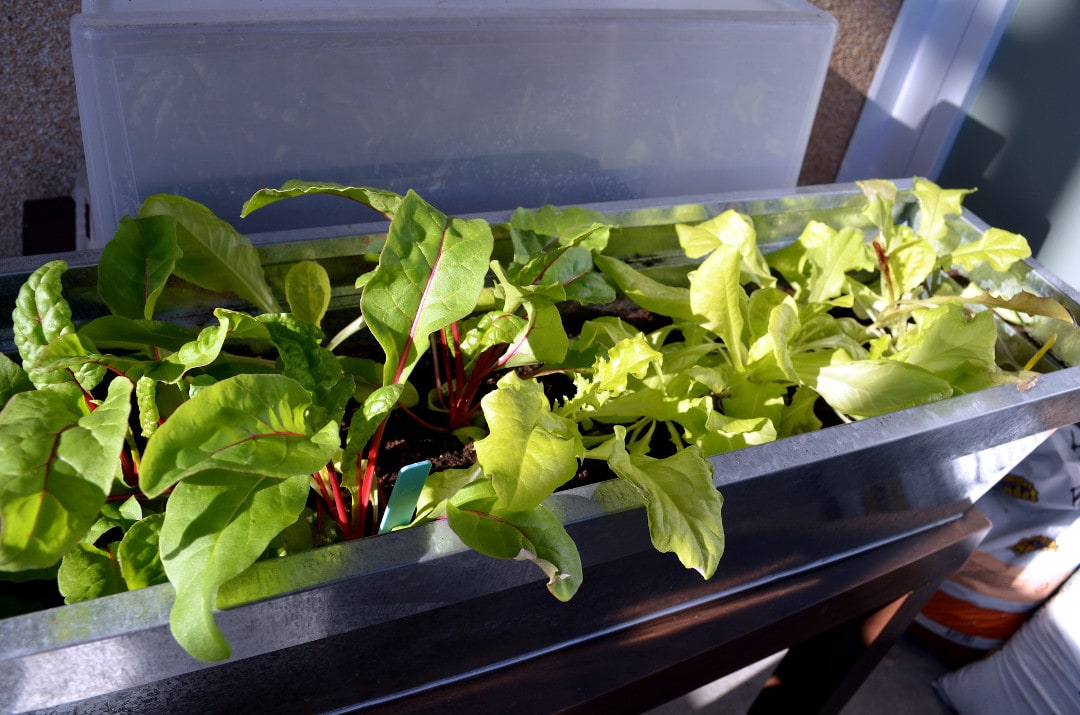
Lettuce and greens are generally easy to grow, but several diseases and issues can affect their production. Here are some more common problems you might experience when growing these leafy plants in pots.
- Failure to germinate – This happens most often because the seeds were buried too deep. Make sure to only cover the seeds with a thin layer of dirt. Soil that is too warm can also cause lettuce seeds not to germinate.
- Leaves that curl at the edges or are stunted – This is a common sign that your plant has aphids. These tiny, fleshy bugs often feed on the underside and stems of greens and may not be visible without some detective work. Spraying leaves with soapy water can help remove and kill the bugs.
- Small round holes in leaves – Many pests can cause this issue, but one of the most common perpetrators is the flea beetle. These tiny black, shiny, hopping bugs love arugula and other thick-leaved greens. Sprinkling infected plants with talcum powder will help repel these pests.
- Snails and slugs – These slimy bugs love their greens. They are less of a problem for container plants since these are more difficult for them to access. But if you do encounter them, try mulching your greens with red cedar bark to repel these slimy pests or fill a small jar with beer and set it in the pot to attract and kill the bugs.
Keeping your container garden away from other ground plants and gardens will help reduce issues with pests. It is also a good idea to clean pots with soapy water and use fresh soil each season to avoid harboring eggs and larvae. Weeds are commonplace with all growing environments, so weed, accordingly.
FAQ
Does lettuce need full sun?
Yes, lettuce needs at least six hours of sunlight per day. However, they are cool-season plants, so a sunny location that doesn’t get overly hot is the best place to grow lettuce.
What is the best container to grow lettuce in?
Most lettuce varieties have shallow root systems and grow well in shallow containers. Choosing one of these less-deep containers allows you to maximize surface area and grow more lettuce per cubic foot.
How often should I water lettuce in containers?
In the cool part of spring, lettuce only needs to be watered about twice a week. As it gets warmer, you’ll likely need to water more often. If the top one inch of soil is dry, it’s time to water.
Get Your Greens On!
Now that you know how to grow your own greens, it’s time to get creative in how you use them.
We all love a good classic salad. But there are a lot more ways to use your harvest. Here are a few of our favorite lettuce and green-centric recipes.
- Easy Vegan Lettuce Wraps – Large-leafed lettuce makes the perfect boat for these tasty vegan wraps.
- Vegan Cobb Salad – Experiment with different combinations of lettuce and greens to dress this tasty salad.
- Vegan Portabella Burgers with Chipotle Mayo – This recipe calls for romaine, but substituting arugula quickly elevates this dish to the next level.
- Pesto and Red Pepper Sandwich – Any broad leafed lettuce will work for this tasty lunch.
- Easy Vegan Pesto with Basil, Walnut and Kale – This outstanding pasta dish works with both baby and mature kale leaves.
Want more recipes like these? Sign up for our newsletter to get more vegan recipes and tips sent to your inbox.
Wrap Up
Lettuce is a great option for your container garden thanks to its shallow root system, low nutrient needs, and ability to be harvested over and over again.
What is your favorite type of lettuce to grow? Let us know in the comments section below.
- How to Pick the Perfect Watermelon For a Sweet Summer Treat - April 10, 2024
- Future Kind’s Foundations: A Multivitamin Made for Vegans - December 5, 2023
- Does Nutritional Yeast Go Bad? - November 28, 2023

